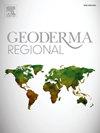Pedotransfer-based bulk density: An alternative approach to enable soil carbon accounting in grain regions of Brazil
IF 3.3
2区 农林科学
Q2 SOIL SCIENCE
引用次数: 0
Abstract
Soil bulk density (BD) is a critical variable in the estimation of carbon (C) stocks, which are central to agriculture-based C projects. However, field sampling of BD is often labor-intensive and costly. Pedotransfer functions (PTFs), which estimate BD from easily measured soil attributes, provide a promising alternative. This study evaluated 6941 observations from plots under grain production (GR) and 1246 from native vegetation (NV), sampled down to 1 m depth across 47 farms in the South-Central region of Brazil. Each observation included BD and the contents of sand, silt, clay, and C. Thirty-three PTFs from the international literature were tested, and four new ones (F34, F35, F36, F37) were developed. Function performance was assessed using the correlation coefficient (r), function efficiency (FE), mean error (ME), and root mean square error (RMSE). Two literature-based PTFs and the four developed in this study achieved the best performance, with RMSE ranging from 0.11 to 0.20 and ME from −0.01 to 0.09. Among them, F36 and F37 showed the strongest predictive ability, with FE values of 0.41 and 0.66 and r of 0.74 and 0.81, respectively. Carbon stocks estimated from BD predicted by the selected PTFs were strongly correlated with measured stocks (r > 0.90), demonstrating that these functions are reliable alternatives to direct BD measurements for estimating C stocks. For conservative application in C projects, function F37 is recommended for layers below 30 cm, while BD should continue to be directly measured in shallower layers, where management practices exert stronger influence.
基于土壤转移的体积密度:在巴西粮食地区实现土壤碳核算的另一种方法
土壤容重(BD)是估算碳储量的关键变量,是农业碳项目的核心。然而,BD的现场采样往往是劳动密集型和昂贵的。土壤传递函数(ptf)是一种很有前途的替代方法,它可以从容易测量的土壤属性中估计出BD。本研究评估了来自粮食生产(GR)地块的6941个观测值和来自原生植被(NV)的1246个观测值,采样深度为1 m,分布在巴西中南部地区的47个农场。对国际文献中的33个PTFs进行了测试,并开发了4个新的PTFs (F34、F35、F36、F37)。使用相关系数(r)、功能效率(FE)、平均误差(ME)和均方根误差(RMSE)评估功能性能。2种基于文献的ptf和本研究开发的4种ptf表现最佳,RMSE范围为0.11 ~ 0.20,ME范围为- 0.01 ~ 0.09。其中F36和F37的预测能力最强,FE分别为0.41和0.66,r分别为0.74和0.81。所选ptf预测的从BD估计的碳储量与实测储量密切相关(r > 0.90),表明这些函数是直接测量BD估算碳储量的可靠替代方法。对于C项目保守应用,建议在30cm以下的层数使用F37函数,而在管理实践影响较大的较浅层数继续直接测量BD。
本文章由计算机程序翻译,如有差异,请以英文原文为准。
求助全文
约1分钟内获得全文
求助全文
来源期刊

Geoderma Regional
Agricultural and Biological Sciences-Soil Science
CiteScore
6.10
自引率
7.30%
发文量
122
审稿时长
76 days
期刊介绍:
Global issues require studies and solutions on national and regional levels. Geoderma Regional focuses on studies that increase understanding and advance our scientific knowledge of soils in all regions of the world. The journal embraces every aspect of soil science and welcomes reviews of regional progress.
 求助内容:
求助内容: 应助结果提醒方式:
应助结果提醒方式:


